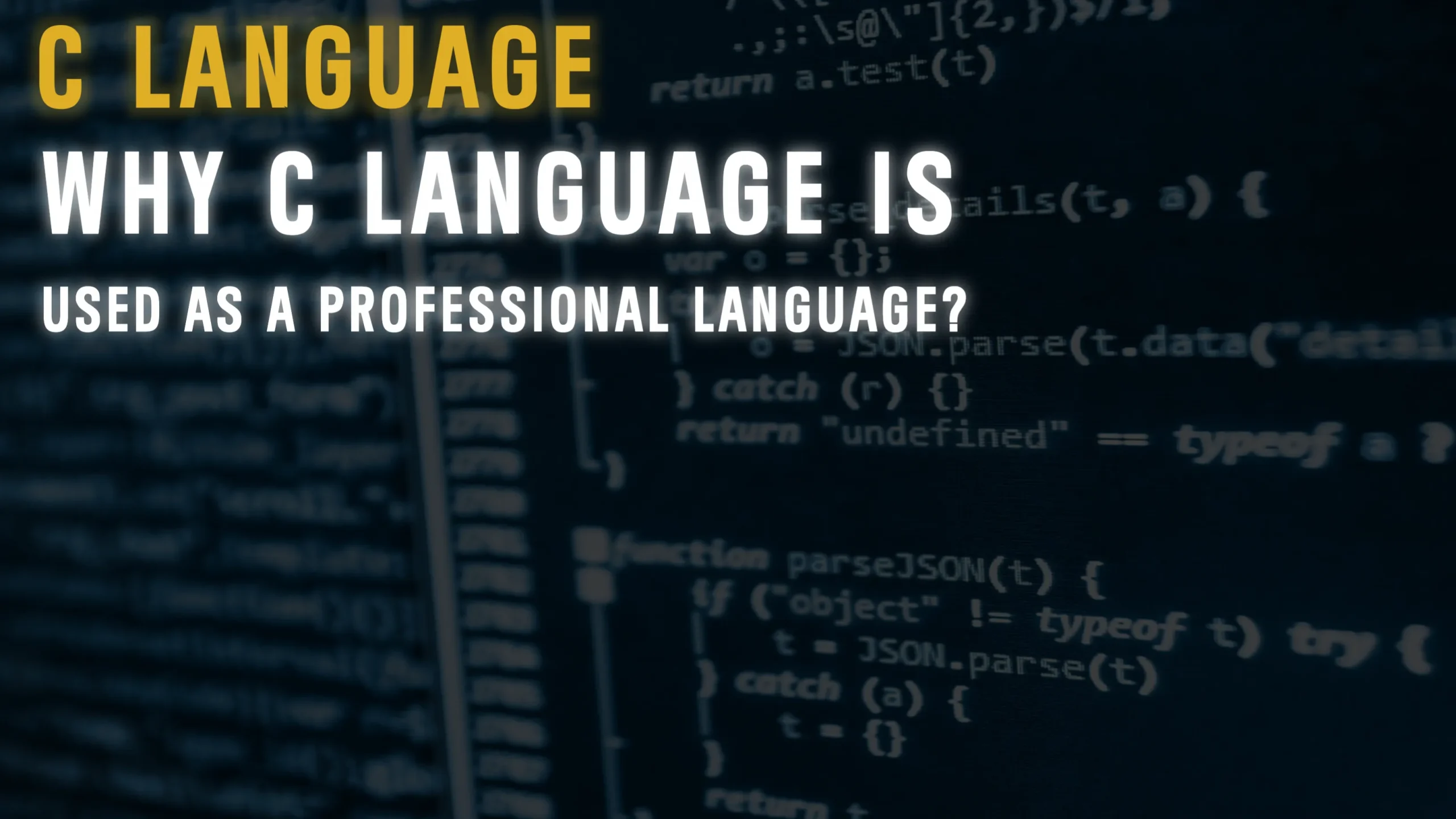what is c-programming language
C Language: Are you ready to dive into the world of coding and discover the thrill of creating software that changes the world? If so, then C language is the perfect place to start. C-language is a programming language that has stood the test of time and continues to inspire developers of all levels. It’s a language that evokes a range of emotions, from the excitement of solving complex problems to the satisfaction of seeing your code come to life.
Learning C-language is an experience that inspires curiosity and creativity. It challenges you to think critically and solve problems in new and innovative ways. And with its efficiency, portability, and flexibility, It’s language allows you to push the boundaries of what’s possible, to explore new frontiers of technology, and to create software that changes the world.
Whether you’re just starting out on your coding journey or you’re a seasoned professional looking for a new challenge, C language has something to offer. It’s a language that embodies the thrill of discovery and the joy of creation, and it has the power to take you on a journey of learning and growth that you’ll never forget.
So, join us on this exciting journey of exploring C language. Let’s unlock the potential of coding together and create software that makes a difference. Get ready to experience the emotions of excitement, creativity, and curiosity as we dive into the world of C language!
- Demystifying PHP: What It Is and Why It’s Important for Web Development
- What is Databases how it’s work
what is c programming language
C programming language is a high-level, general-purpose programming language that was developed in the early 1970s by Dennis Ritchie at Bell Labs. It is a compiled language, which means that code written in C is compiled into machine-readable code before it can be executed.
C is widely regarded as one of the most influential programming languages in history, and it has been used to develop a wide range of software, from operating systems and device drivers to databases, compilers, and scientific simulations.
One of the reasons for C’s enduring popularity is its efficiency and portability. Because C is a low-level language, it allows programmers to directly manipulate computer hardware, making it ideal for system programming and applications that require high performance. Additionally, C code is highly portable, meaning that it can be compiled and run on a wide variety of platforms, including computers, mobile devices, and embedded systems.
C also features a rich set of libraries and tools that make it easier to write complex code, such as memory management, data structures, and I/O operations. Furthermore, C’s syntax and structure have influenced the development of many other programming languages, including C++, Java, and Python.
Why C Language is used as a professional language?
C Language is used as a professional language for several reasons. Here are a few of them:
1. Efficiency:
C Language is known for its efficiency in terms of speed and memory usage. It is a low-level language that allows developers to have direct control over the computer’s hardware. As a result, programs written in C can run faster and use less memory than programs written in other high-level languages.
2. Portability:
C Language is highly portable, which means that code written in C can be compiled and run on a wide range of platforms. This makes it an ideal language for developing software that needs to run on multiple devices or operating systems.
3. Reliability:
It Language is a robust and reliable language that has been used for decades in the development of critical software, such as operating systems, compilers, and device drivers. It has a well-established set of libraries and tools that make it easier to write complex code.
4. Influence:
It Language has influenced the development of many other programming languages, including C++, Java, and Python. This means that learning “C” can provide a strong foundation for learning other programming languages, which can be useful for professional development.
What is the first book based on C Programming?
The first book based on C Programming is “The C Programming Language” written by Brian Kernighan and Dennis Ritchie.
This book, often referred to as the “K&R” book, was published in 1978 and became the standard reference for the C programming language. It introduced the language and its features in a concise and straightforward manner and included numerous examples and exercises to help readers understand and practice the concepts.
The K&R book is considered a classic in the field of computer science and is still widely used today by programmers and students alike. It has been translated into many languages and has helped countless individuals learn the C programming language and become proficient programmers.
What are the features of C Programming Language?
C Programming Language is a versatile and powerful language that has been widely used for developing software in a variety of fields, including system programming, application development, and scientific computing. Some of the key features of C Language include:
1. Efficiency:
C is known for its efficiency in terms of speed and memory usage. It is a low-level language that allows developers to have direct control over the computer’s hardware, making it ideal for developing high-performance and critical software.
2. Portability:
“C” is highly portable, which means that code written in C can be compiled and run on a wide range of platforms. This makes it an ideal language for developing software that needs to run on multiple devices or operating systems.
3. Rich Library:
“C” comes with a rich set of libraries and tools that make it easier to write complex code, such as memory management, data structures, and I/O operations.
4. Modularity:
C Language supports modularity, which means that programs can be broken down into smaller, more manageable parts. This makes it easier to develop and maintain large-scale software projects.
5. Flexibility:
“C” is a flexible language that allows programmers to choose between procedural, functional, and object-oriented programming paradigms. This means that C Language can be used for a wide range of applications and can adapt to the needs of different programming projects.
6. Influence:
“C” has had a significant influence on the development of many other programming languages, including C++, Java, and Python. This means that learning C Language can provide a strong foundation for learning other programming languages, which can be useful for professional development.
General Purpose of C Language
“C” is a general-purpose programming language, which means that it can be used for a wide range of applications and purposes. Some of the general purposes of C Language include:
1. System programming:
C Language was initially designed for system programming, which involves developing software that interacts directly with the computer’s hardware. This makes C programming ideal for developing operating systems, device drivers, and other low-level software.
2. Application development:
C Language can also be used for developing applications, such as desktop software, mobile apps, and web applications. It provides a wide range of libraries and tools that make it easier to develop complex software.
3. Scientific computing:
C Language is widely used in scientific computing, where it is used to develop software for numerical analysis, data processing, and simulations. Its efficiency and ability to handle large amounts of data make it well-suited for these types of applications.
4. Embedded systems:
C Language is commonly used in embedded systems, which are computer systems that are integrated into other devices. This includes everything from smartphones and cars to medical devices and industrial machinery.
Interesting Facts about C Language
C Language is one of the most widely used and influential programming languages in history. Here are some interesting facts about C Language:
1. C Language was developed at Bell Labs in the early 1970s by Dennis Ritchie as an extension of the B Language. It was designed to be a low-level language that could be used to develop operating systems and other system software.
2. The first version of C Language was released in 1972. It was initially used to develop the Unix operating system, which is still widely used today.
3. C Language has been used to develop many popular software applications, including the Linux operating system, the MySQL database, and the Apache web server.
4. C Language has had a significant influence on the development of many other programming languages, including C++, Java, and Python. Many modern programming languages borrow syntax and concepts from C Language.
5. The C Language standard is maintained by the International Organization for Standardization (ISO) and the American National Standards Institute (ANSI). The most widely used version of the standard is C99, which was released in 1999.
6. C Language is still widely used today, particularly in system programming and embedded systems. Despite the rise of newer programming languages, C Language remains an important language for many software developers.
7. C Language has a rich history and culture, with many books, articles, and websites dedicated to teaching and promoting the language. The “K&R” book, written by Brian Kernighan and Dennis Ritchie, is considered a classic and remains a popular resource for learning C Language.
How to learn C language
Learning C Language can be a challenging but rewarding experience. Here are some steps you can take to learn C Language:
1. Understand the basics:
Before diving into coding, it’s important to understand the basic concepts of programming and the structure of C Language. You can start by learning about variables, data types, functions, control structures, and arrays.
2. Find a good resource:
There are many resources available for learning C Language, including books, online courses, and tutorials. Look for a resource that matches your learning style and provides clear explanations and examples.
3. Practice coding:
The best way to learn C Language is to practice coding. Start with simple programs and gradually work your way up to more complex projects. There are many websites and tools available that allow you to practice coding online.
4. Join a community:
Joining a community of C Language learners and developers can be a great way to get support, ask questions, and learn from others. There are many online forums, chat rooms, and social media groups dedicated to C Language.
5. Build projects:
As you gain more experience with C Language, try building your own projects. This will help you apply what you’ve learned and gain valuable experience. Start with small projects and gradually work your way up to larger, more complex projects.
6. Keep learning:
C-Language is a constantly evolving language, so it’s important to keep learning and staying up-to-date with the latest developments. Attend conferences, read blogs and articles, and continue to practice coding to improve your skills.
You can learn c language for free from these websites
There are several websites where you can learn C Language for free. Here are some popular options:
1. Codecademy:
Codecademy is an interactive online platform that offers free courses in “C” Language programming. The courses are designed for beginners and provide a hands-on learning experience.
2. edX:
edX is a platform that offers free online courses from top universities, including courses in “C” Language programming. The courses are self-paced and offer video lectures, quizzes, and coding exercises.
3. Coursera:
Coursera is another online platform that offers free courses in “C” Language programming. The courses are taught by professors from top universities and offer a mix of video lectures, quizzes, and programming assignments.
4. Khan Academy:
Khan Academy offers free online courses in a variety of subjects, including C Language programming. The courses are designed for beginners and provide step-by-step instructions and coding exercises.
5. Learn-C.org:
Learn-C.org is a free online tutorial that provides a comprehensive introduction to “C” Language programming. The tutorial includes interactive coding exercises and quizzes to test your knowledge.
6. w3schools.com
w3schools.com is also a popular website for learning C Language, as well as many other programming languages. It offers free tutorials, examples, and exercises for beginners, as well as more advanced topics for experienced programmers.
The website has a user-friendly interface and provides a hands-on learning experience with its interactive coding exercises. It’s a great resource for anyone looking to learn “C” Language or other programming languages.
7. Udemy.com
Udemy.com is another popular website for learning C Language and other programming languages. It offers a wide variety of online courses taught by industry professionals and experienced instructors. The courses are self-paced and allow students to learn at their own speed.
The website offers both free and paid courses, and the paid courses come with a certificate of completion. The platform is user-friendly and offers a comprehensive learning experience with video lectures, coding exercises, quizzes, and downloadable resources. It’s a great resource for anyone looking to learn “C” Language or other programming languages from the comfort of their own home.
C language learning platform
A C language IDE, or Integrated Development Environment, is a software application that provides a comprehensive environment for developing, testing, and debugging programs written in the C programming language. It typically includes a code editor, a compiler, a debugger, and other tools that make the process of writing and testing C code more efficient and streamlined.
The code editor in a IDE usually includes features such as syntax highlighting, code completion, and code formatting to make writing code easier and more error-free. The compiler included in the IDE allows developers to compile their C code into executable programs, which can be run on various operating systems.
A debugger is another important feature of a this IDE, which allows developers to step through their code line-by-line to identify and fix errors and bugs. It typically includes features such as setting breakpoints, watching variables, and inspecting memory.
Some popular C-language IDEs include:
1. Visual Studio Code:
a free, open-source IDE that is highly customizable and supports a wide range of programming languages, including C.
2. Eclipse:
a popular IDE that has a C/C++ Development Tooling (CDT) plugin, which provides powerful tools for developing and debugging C code.
3. Code::Blocks:
a lightweight IDE that is designed specifically for C and C++ development. It is easy to use and provides a range of features, including code completion and syntax highlighting.
4. NetBeans:
another popular IDE that supports C and C++ development. It includes a range of features such as code highlighting, code completion, and project management tools.
5. Dev-C++:
a free, open-source IDE that is designed specifically for C and C++ development. It includes a range of features such as code highlighting, code completion, and debugging tools.
Why is C language used?
The c language is used for several reasons at a professional level:
1. Portability:
“C” Language is a portable programming language, which means it can be run on various computer platforms. It runs on any operating system, such as Windows, Linux, and macOS.
2. Speed:
C-Language is a low-level programming language in which code can be built closer to machine-level code. As a result, programs written in C are faster and more efficient than other high-level programming languages.
3. Efficiency:
“C” Language provides access to low-level memory management, which makes it more efficient in handling system-level resources such as memory and CPU usage.
4. Flexibility:
“C” Language is a versatile programming language that can be used for developing a wide range of applications such as operating systems, compilers, text editors, and even video games.
5. Legacy Code:
“C” Language has been around for over four decades and is still widely used today. As a result, many legacy systems and applications are written in C Language, making it a valuable language for maintaining and updating these systems.
Where is c language used
C Language is used in a variety of applications and industries, including:
1. Operating Systems:
“C” Language is widely used for developing operating systems such as Linux, Windows, and macOS. The kernel of these operating systems is written in C.
2. Embedded Systems:
“C” Language is often used in developing embedded systems such as microcontrollers, sensors, and other small-scale devices. This is because it provides access to low-level hardware, allowing developers to write code that can interact with the system hardware directly.
3. Gaming:
“C” Language is used in developing video games due to its efficiency, speed, and ability to handle complex algorithms and graphics.
4. Compilers and Interpreters:
C Language is used in developing compilers and interpreters for other programming languages. These are essential tools for translating high-level programming languages into machine language that the computer can understand.
5. System Programming:
“C” Language is often used for system-level programming, such as developing device drivers, network protocols, and system utilities.
6. Web Development:
C Language is not commonly used for web development; however, it can be used for server-side programming and developing web applications that require high-performance computing.
[faq id=”1272″]
Conclusion
C Language is a fundamental programming language that has stood the test of time. It is widely used in the software industry and has been instrumental in the development of some of the most important applications we use today, such as operating systems, compilers, and video games.
“C” Language’s simplicity, efficiency, and flexibility make it a popular choice for programmers. It is also an essential language for anyone learning programming because it provides a solid foundation for understanding how computers work.
While there are many other programming languages available today, “C” Language continues to be a language of choice for many developers due to its portability, speed, and ability to handle low-level memory management.
Whether you are a seasoned developer or just starting in programming, “C” Language is a language that you should consider learning. Its impact on the world of computing cannot be overstated, and its relevance in the software industry remains significant today.





Fast and furious
Can you be more specific about the content of your article? After reading it, I still have some doubts. Hope you can help me. https://www.binance.info/ph/join?ref=V2H9AFPY
I appreciate your insightful post. It was actually pretty fun. You seem to have reached a far more agreeable level now. But how can we continue to communicate?
Your article helped me a lot, is there any more related content? Thanks! https://accounts.binance.com/en/register-person?ref=WTOZ531Y
Thank you for the auspicious writeup It in fact was a amusement account it Look advanced to more added agreeable from you By the way how could we communicate